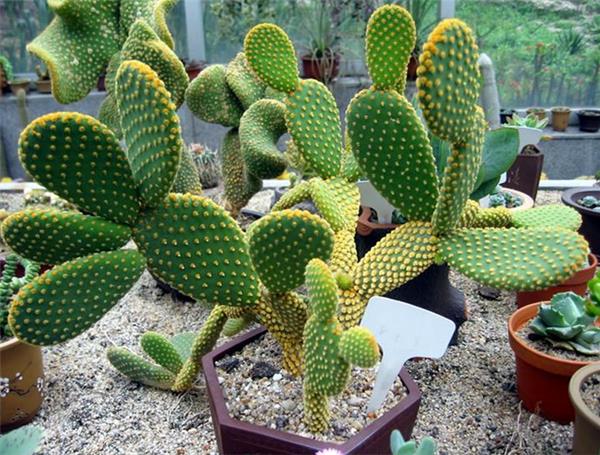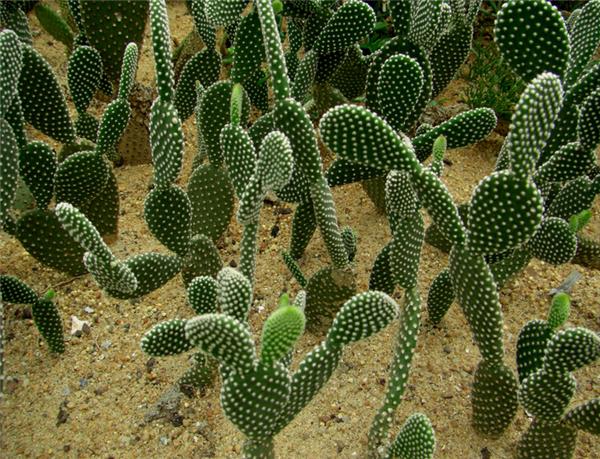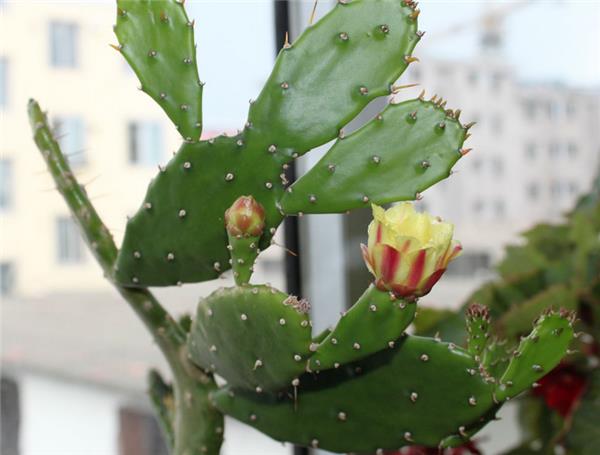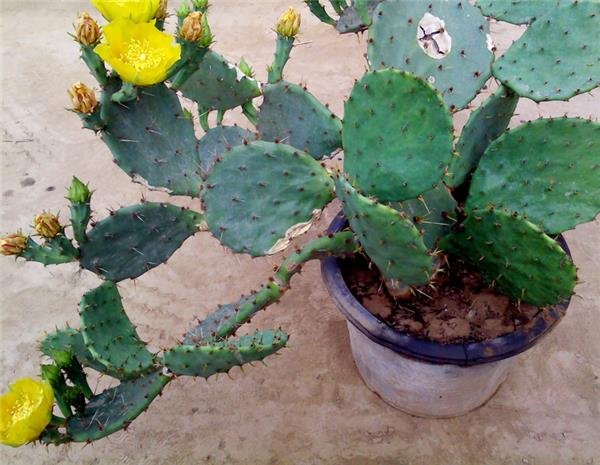Does the cactus have leaves?
Does the cactus have leaves? This is the question of many people, let's give a brief introduction.

Does the cactus have leaves?
The answer is: yes, but in order to adapt to the dry and rainless desert environment, the cactus has been changing its shape over the long years, and the leaves have gradually disappeared, turning into root spines or dense hairs, minimizing water transpiration. In fact, the thorns of cactus are the leaves of cactus. Cactus comes from the desert with bad climate, so water is not easy to come by. In order to deal with the severe drought, the leaves of the cactus gradually degenerated and turned into needles or thorns, which fundamentally reduced the transpiration surface of the leaves and reduced the water expenditure. Therefore, the thorns of cactus are the leaves of cactus.

The common culture methods of cactus are cuttage propagation, split propagation, sowing propagation and grafting propagation.
1. Cuttage propagation
1. Insert time
Under normal conditions, the most suitable period is from May to June. Where there is a greenhouse, it can be carried out all year round.
2. Preparation of matrix
Cactus is resistant to drought and barren, and avoid stagnant water. Therefore, the matrix must have the characteristics of good air permeability, good drainage and keeping moist, such as vermiculite, perlite and so on. It can also be prepared with 4 parts of coarse river sand, 3 parts of loam, 2 parts of rotten leaves and 1 part of grain husk ash.
3. Cutting cuttings
The robust and mature stem nodes were selected from the mother plant with strong growth potential and free of diseases and insect pests as cuttings. Cut the cuttings from the mother plant with a rust-free scraper and wipe the cutters with alcohol before and after each cut.
4. Dry the cuttings
Cut cuttings should not be cut immediately, but should be hung in a dry room for 5 to 7 days until the cut dries up and the stem begins to shrink.
5. Hormone immersion
For varieties with difficulty in rooting, soaking the base of cuttings with plant growth hormone can greatly improve the survival rate. The method is: soak the base of cuttings with 50 to 100ppmGGR (plant growth regulator) solution for half to one hour, or soak the base of cuttings with 200ml / L naphthalene acetic acid solution for 4 hours. Most other varieties that are easy to take root are implanted without hormone treatment.
6. Plug in
The base of the cuttings will be shallowly buried in the substrate, do not be too deep, resulting in rot. At this time, the cuttings are difficult to stand upright (because they have been softened by drying), so they can be flat on the substrate, or they can be supported by small wooden sticks, and then gently press the soil on both sides of the cuttings with both hands to make it close to the soil.
7. Plug-in management
(1) Water management. It is better for the substrate to be moist when it is inserted, and it is not easy to take root if it is too dry, so you can pour less water from the edge of the basin. But the substrate should not be too wet, otherwise it will easily lead to cuttings rot. Keep the basin soil moist all the time before taking root. In order to reduce water evaporation, plastic bags can be used to cover the basin, the cuttings will take root in a month or so, then the plastic bags should be removed immediately.
(2) Light management. Before taking root, protect yourself from the sun and keep it in a semi-shady place. After rooting, water and light can be managed routinely.

2. Separate plant propagation
Many cacti can grow seed plants, such as spherical cacti grow small balls on the stem, while round fan cacti or segmental cacti will grow young plants. for these varieties, the growing point of the cactus needs to be cut off with a knife, so that after a period of cultivation, many small balls will grow near the growing point, and when the balls grow to the appropriate size, they can be cut off and inserted to breed.
3. Sowing and reproduction
1. Artificial pollination
There are few species of self-insemination in palms. Most of them are cross-pollination, which requires artificial pollination to bear seeds, and more species need the same kind of cross-pollination. Therefore, at least two plants of the same kind should be prepared. Pollination must be carried out when the stamen anther is dehiscent, the pollen matures and the pistil stigma fully secretes mucus. However, the maturation time of pistils and stamens may not be the same in different species.
If the female parent blossoms later than the male parent, the male parent can first be placed in a cool place to make it bloom later, or the pollen of the male parent can be collected and placed in a cold and dry place. Don't take out pollination until the female pistil is mature. Most species have the highest success rate of pollination in 1-2 hours in the afternoon on the second day of flowering. Dip the pollen with a clean brush and gently apply it to the stigma of the female parent or pick up the pollen with fine tweezers and put it on the stigma. If the weather is very hot, the humidity is too large, and there is water on the flowers, the fertilization rate is not high.
2. Cut off the petals
If the ovary gradually expands after pollination, it indicates the success of pollination, and the dry petals can be cut off to prevent mildew. Plants should avoid rain and water flushing, and strengthen fertilizer and water management.
3. Timely seed collection
Cactus fruits generally mature in 50-60 days, and some species are berries, which are easily pecked by birds and other small animals when ripe, and the fruit is protected by net cover. The pericarp of some fruits is easy to crack, so we should pay attention to timely harvest. The harvested berries should be peeled off, the seeds washed, and then filtered dry. The obtained seeds should be packed in a paper bag and placed in a dry and cold place, indicating the name of the seed and the date of harvest.
4. Disinfect and soak the seeds
Sowing soil should be disinfected river sand or mixed sand rotten leaf soil, must be stir-fried or steamed, can not be disinfected with medicament. Before sowing, wet the pot soil with soaking method, then soak the seeds with 1% formalin or 2.5% copper sulfate solution for 15 minutes, remove and clean and sow the seeds. Small seeds can be evenly sown on the soil surface with mixed sand without covering the soil. Large seeds can be sown on demand according to the row spacing of 5mm × 5mm.
5. Sowing at the right time
The best time for seed propagation of cactus is in spring and autumn, where there is a large temperature difference between day and night. Large temperature difference can not only increase the emergence rate, but also accelerate the growth of seedlings. Sowing on cloudy and rainy days should be avoided and sunny weather should be chosen. If in the greenhouse, seed reproduction can be carried out in all four seasons.
6. Seminal ducts after sowing
After sowing, a glass plate is used to cover the flowerpot, and a seam must be exposed regularly every day to breathe. General cactus species can sprout within 15 days. After germination, the dry and wet conditions in the basin should be carefully observed to keep the surface of the basin soil moist. The seedlings must control the light and cover the glass with perforated white paper. With the growth of the seedlings to replace the white paper, so that the corresponding increase in the number of holes, in order to facilitate light. The seedling management of cactus should be strictly controlled in temperature, humidity, moisture, light and ventilation. Spring and autumn growth peak season, to maintain a large temperature difference between day and night, and timely and appropriate amount of light to the seedlings. In summer, ventilation should be strengthened and the temperature should be lowered. Winter should be placed in a warm place indoors, and appropriate increase in light, but not excessive. Watering should be based on the soaking basin method, and the basin surface can be moist.

IV. Grafting propagation
Grafting is a horticultural technique commonly used in cactus, because the root system of some cactus is very fragile, after long-term cultivation, the root system will gradually lose its original function and disappear, and the plant will lose its vitality. Grafting is a panacea to save these cacti. In addition, such as accelerating the growth rate of cactus or allowing diseased plants of root rot to continue to grow after removal of the affected area, grafting can be used to achieve the goal.
When grafting, the selected rootstock-triangular column is one of this kind of cactus. The method is to remove the growing point of the triangular column and cut it off obliquely on the edges and corners, then put the cactus with the root system in the center of the rootstock, and then fix the position with rope or weight. After 1-2 weeks, the rope and weight can be removed.
The harvested berries should be peeled off, the seeds washed, and then filtered dry. The obtained seeds should be packed in a paper bag and placed in a dry and cold place, indicating the name of the seed and the date of harvest.
4. Disinfect and soak the seeds
Sowing soil should be disinfected river sand or mixed sand rotten leaf soil, must be stir-fried or steamed, can not be disinfected with medicament. Before sowing, wet the pot soil with soaking method, then soak the seeds with 1% formalin or 2.5% copper sulfate solution for 15 minutes, remove and clean and sow the seeds. Small seeds can be evenly sown on the soil surface with mixed sand without covering the soil. Large seeds can be sown on demand according to the row spacing of 5mm × 5mm.
5. Sowing at the right time
The best time for seed propagation of cactus is in spring and autumn, where there is a large temperature difference between day and night. Large temperature difference can not only increase the emergence rate, but also accelerate the growth of seedlings. Sowing on cloudy and rainy days should be avoided and sunny weather should be chosen. If in the greenhouse, seed reproduction can be carried out in all four seasons.
6. Seminal ducts after sowing
After sowing, a glass plate is used to cover the flowerpot, and a seam must be exposed regularly every day to breathe. General cactus species can sprout within 15 days. After germination, the dry and wet conditions in the basin should be carefully observed to keep the surface of the basin soil moist. The seedlings must control the light and cover the glass with perforated white paper. With the growth of the seedlings to replace the white paper, so that the corresponding increase in the number of holes, in order to facilitate light. The seedling management of cactus should be strictly controlled in temperature, humidity, moisture, light and ventilation. Spring and autumn growth peak season, to maintain a large temperature difference between day and night, and timely and appropriate amount of light to the seedlings. In summer, ventilation should be strengthened and the temperature should be lowered. Winter should be placed in a warm place indoors, and appropriate increase in light, but not excessive. Watering should be based on the soaking basin method, and the basin surface can be moist.

IV. Grafting propagation
Grafting is a horticultural technique commonly used in cactus, because the root system of some cactus is very fragile, after long-term cultivation, the root system will gradually lose its original function and disappear, and the plant will lose its vitality. Grafting is a panacea to save these cacti. In addition, such as accelerating the growth rate of cactus or allowing diseased plants of root rot to continue to grow after removal of the affected area, grafting can be used to achieve the goal.
When grafting, the selected rootstock-triangular column is one of this kind of cactus. The method is to remove the growing point of the triangular column and cut it off obliquely on the edges and corners, then put the cactus with the root system in the center of the rootstock, and then fix the position with rope or weight. After 1-2 weeks, the rope and weight can be removed.
Related
- Wuhan Hospital Iron Tree Blooming Result Was Instantly Frightened by the Gardener Master
- Which variety of camellia is the most fragrant and best? Which one do you like best?
- What is the small blue coat, the breeding methods and matters needing attention of the succulent plant
- Dormancy time and maintenance management of succulent plants during dormancy
- Minas succulent how to raise, Minas succulent plant pictures
- What are the varieties of winter succulent plants
- How to raise succulent plants in twelve rolls? let's take a look at some experience of breeding twelve rolls.
- Attention should be paid to water control for succulent plants during dormant period (winter and summer)
- Watering experience of twelve rolls of succulent plants
- Techniques for fertilizing succulent plants. An article will let you know how to fertilize succulent plants.



